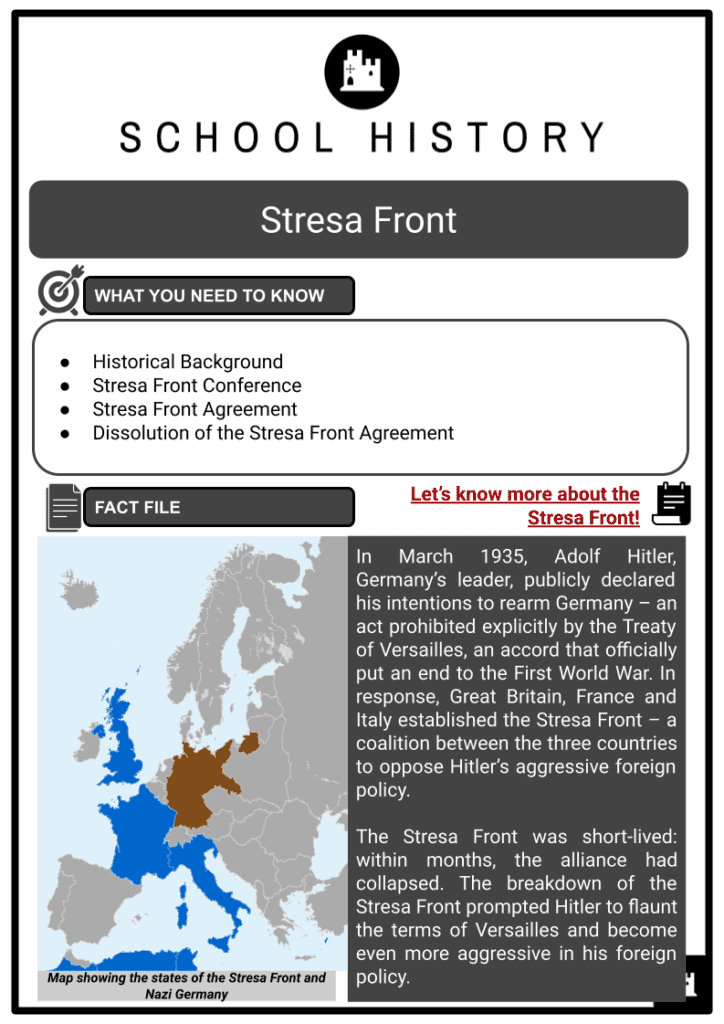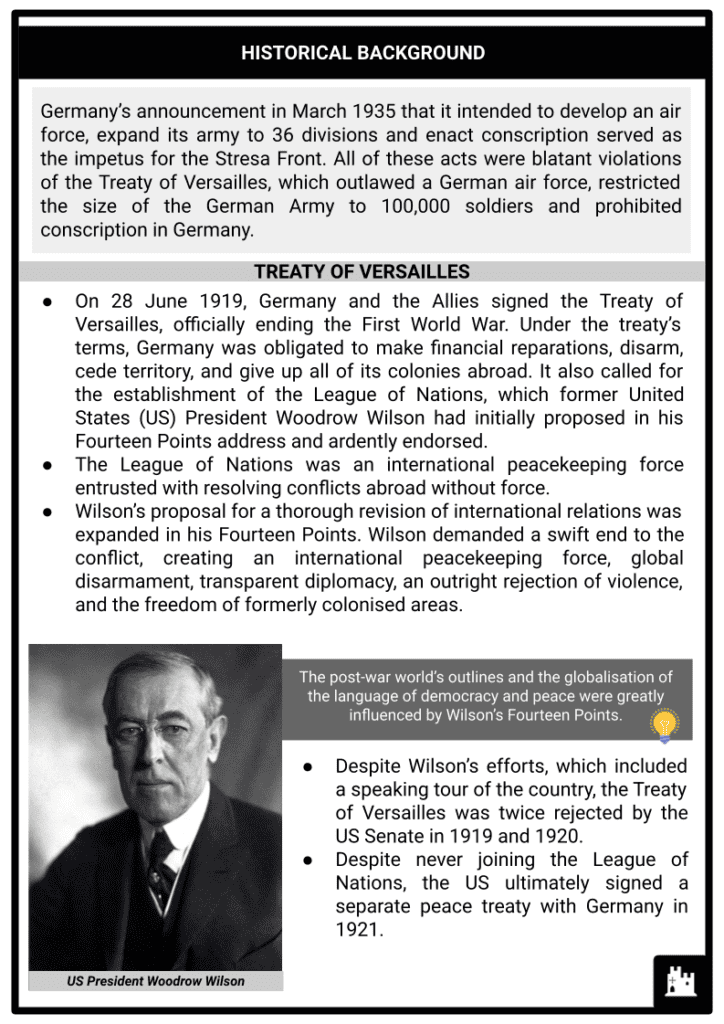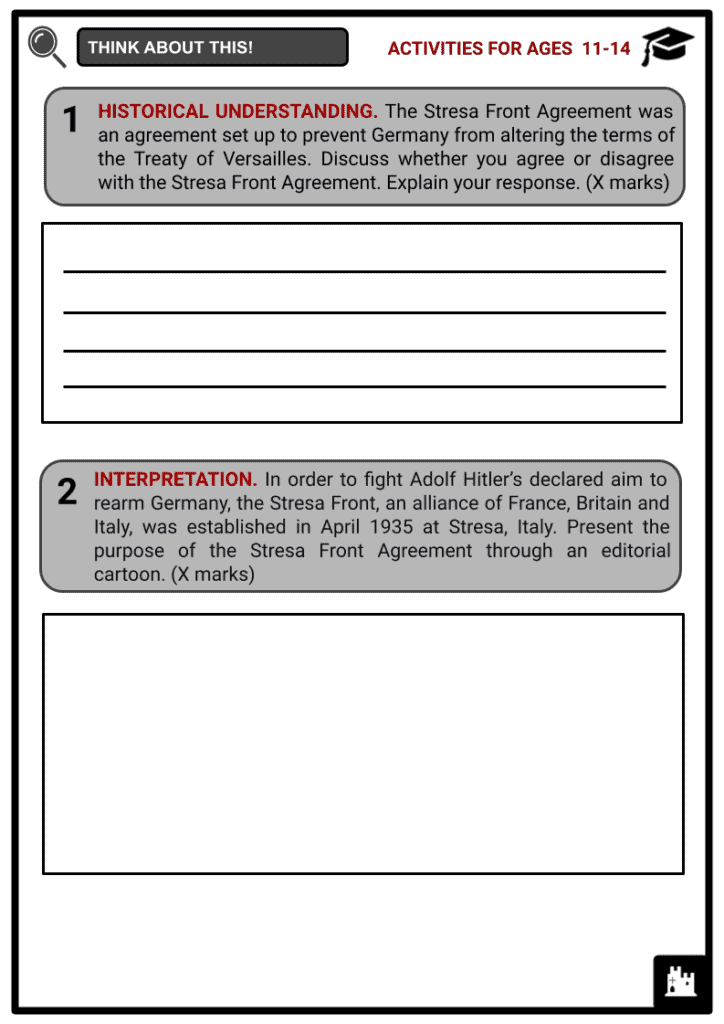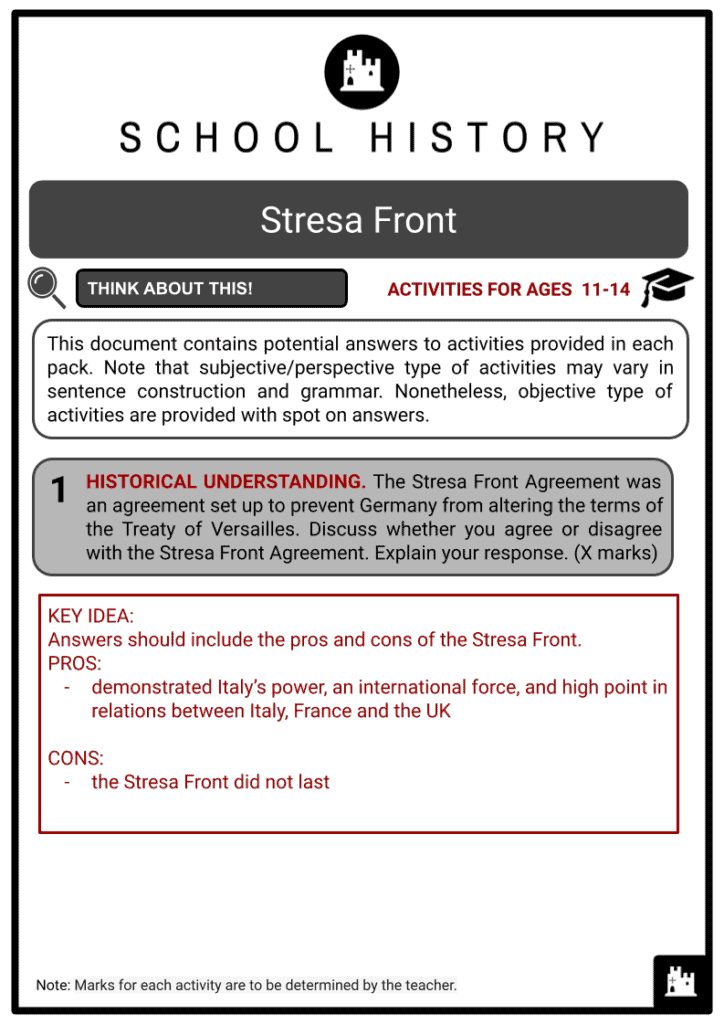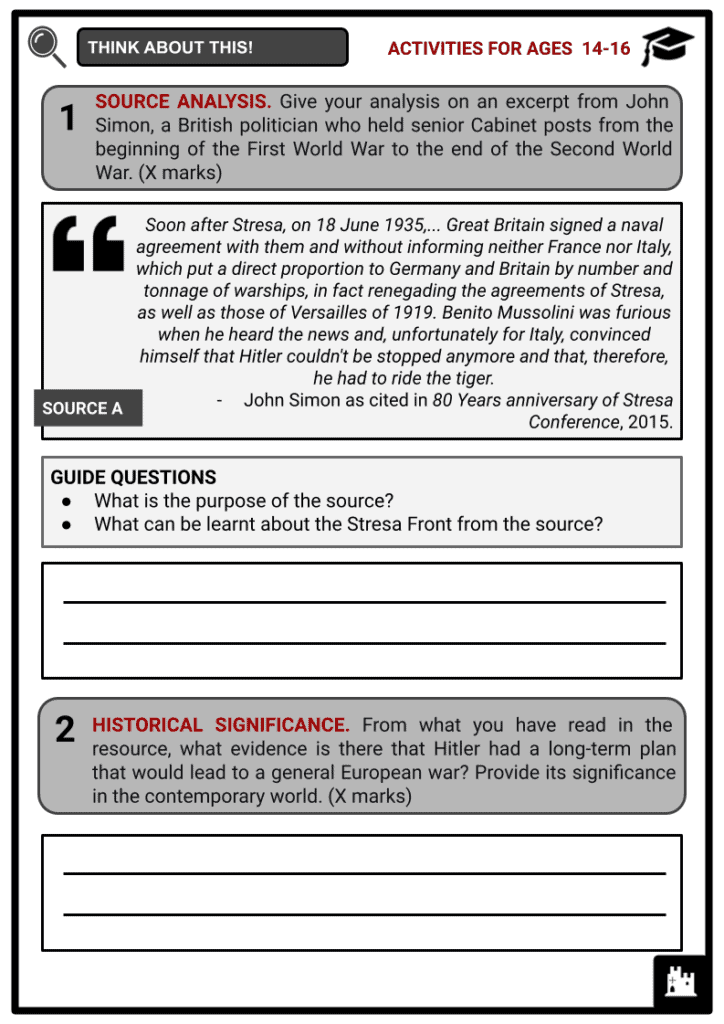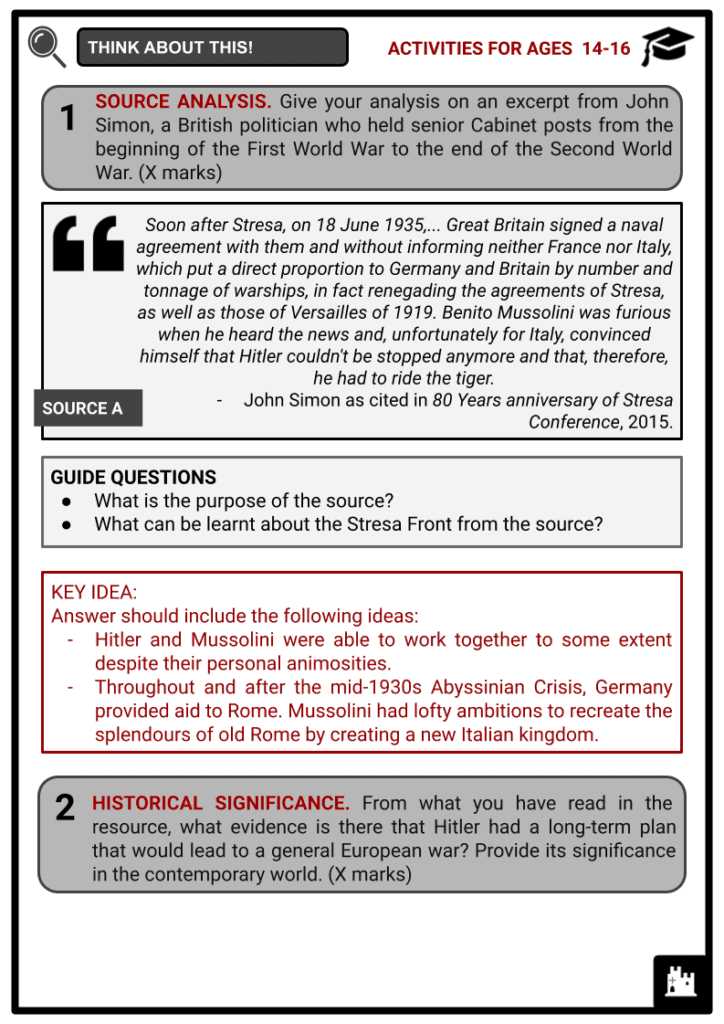Stresa Front Worksheets
Do you want to save dozens of hours in time? Get your evenings and weekends back? Be able to teach about the Stresa Front to your students?
Our worksheet bundle includes a fact file and printable worksheets and student activities. Perfect for both the classroom and homeschooling!
Summary
- Historical Background
- Stresa Front Conference
- Stresa Front Agreement
- Dissolution of the Stresa Front Agreement
Key Facts And Information
Let’s know more about the Stresa Front!
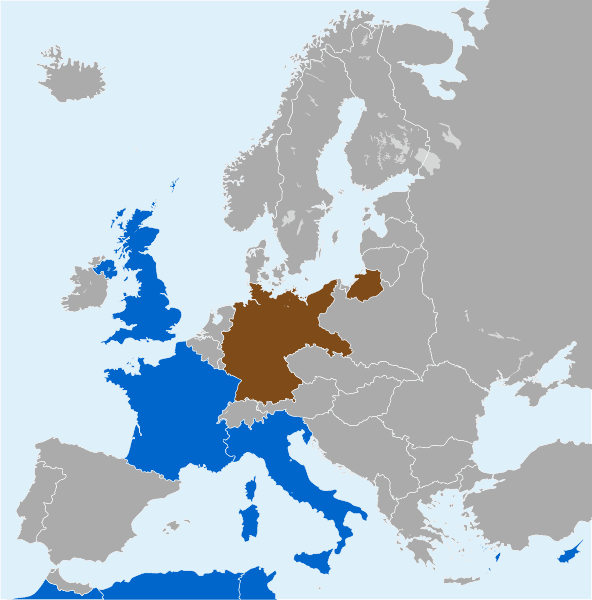
In March 1935, Adolf Hitler, Germany’s leader, publicly declared his intentions to rearm Germany – an act prohibited explicitly by the Treaty of Versailles, an accord that officially put an end to the First World War. In response, Great Britain, France and Italy established the Stresa Front – a coalition between the three countries to oppose Hitler’s aggressive foreign policy. The Stresa Front was short-lived: within months, the alliance had collapsed. The breakdown of the Stresa Front prompted Hitler to flaunt the terms of Versailles and become even more aggressive in his foreign policy.
HISTORICAL BACKGROUND
- Germany’s announcement in March 1935 that it intended to develop an air force, expand its army to 36 divisions and enact conscription served as the impetus for the Stresa Front. All of these acts were blatant violations of the Treaty of Versailles, which outlawed a German air force, restricted the size of the German Army to 100,000 soldiers and prohibited conscription in Germany.
TREATY OF VERSAILLES
- On 28 June 1919, Germany and the Allies signed the Treaty of Versailles, officially ending the First World War. Under the treaty’s terms, Germany was obligated to make financial reparations, disarm, cede territory, and give up all of its colonies abroad. It also called for the establishment of the League of Nations, which former United States (US) President Woodrow Wilson had initially proposed in his Fourteen Points address and ardently endorsed.
- The League of Nations was an international peacekeeping force entrusted with resolving conflicts abroad without force.
- Wilson’s proposal for a thorough revision of international relations was expanded in his Fourteen Points. Wilson demanded a swift end to the conflict, creating an international peacekeeping force, global disarmament, transparent diplomacy, an outright rejection of violence, and the freedom of formerly colonised areas.
- The post-war world’s outlines and the globalisation of the language of democracy and peace were greatly influenced by Wilson’s Fourteen Points.
- Despite Wilson’s efforts, which included a speaking tour of the country, the Treaty of Versailles was twice rejected by the US Senate in 1919 and 1920.
- Despite never joining the League of Nations, the US ultimately signed a separate peace treaty with Germany in 1921.
TERMS & CONSEQUENCES OF THE TREATY OF VERSAILLES
- The Treaty of Versailles established a framework for the post-war world. The War Guilt Clause, which expressly and unambiguously attributed responsibility for starting hostilities to Germany, was one of the treaty’s most contentious provisions.
- The deal compelled Germany to disarm, give up territory, and pay $5 billion in reparations to the Allied nations. Despite Wilson’s opposition to such severe terms, French Prime Minister Georges Clemenceau outwitted him.
- Most of the destruction and casualties caused by the German war machine fell on France because it was the only Allied country to border Germany. The French sought to weaken Germany as much as they could.
- The Treaty of Versailles, which mirrored President Wilson’s vision for the post-war world, was carefully negotiated, but isolationists in the US Congress posed a significant obstacle to approval.
- The so-called Irreconcilables, who were primarily Republicans but also some Democrats, opposed the treaty, especially Article X, which required members of the League of Nations to declare war on one another in the event of an unprovoked act of aggression.
- Many of the Treaty of Versailles provisions were broken when Adolf Hitler took office in Germany in 1934 as Führer. Hitler started thoughtfully constructing the German military forces and declaring a halt to all debt payments and reparations.
- According to some historians, the burdensome provisions of the treaty helped pave the way for the rise of the Nazi Party, which tapped into German resentment of the obligations the Allies placed on the country after the First World War.
STRESA FRONT CONFERENCE
- Baron Vansittart of the British diplomatic corps was responsible for the Stresa Front in many ways. Vansittart fought adamantly against appeasement and in favour of keeping Germany under control. Doing so had the practical result of caving into Italian wishes in Ethiopia.
- A four-day seminar was scheduled to begin on 11 April 1935 in Stresa by Vansittart.
- Despite some early challenges, Vansittart proved to be the conference’s driving force. Just before the Stresa conference, British Viscount Simon met with German authorities in Berlin, much to the great dismay of Italy and France.
- Vansittart went to enormous pains to allay the fears of the Italians and French that Britain might seek to make peace with the Nazis. He did this by disseminating diplomatic knowledge gleaned through Simon’s contacts in Berlin.
- The Abyssinian issue dogged the conference. Britain responded to Italy’s request for specialists in the field. But the Abyssinian case was postponed until the meeting to resolve the European matter.
- There were various solutions to this issue. Although Abyssinia is not mentioned in official records, anecdotal evidence suggests that Benito Mussolini, Italy’s fascist leader, wanted to keep the Stresa Front’s reach to Europe to give Abyssinia free rein.
- The British believed it was evident that Abyssinia was off-limits, whereas the Italians thought they could travel freely there.
STRESA FRONT AGREEMENT
- Benito Mussolini, the leader of Italy, Pierre-Etienne Flandin, the leader of France, and Ramsay MacDonald, the leader of Britain, met in Stresa, Italy, on 14 April 1935. The three leaders were apprehensive about Nazi Germany and desired to take action. The Stresa Front Agreement, also known as The Final Declaration of the Stresa Conference, was the meeting’s outcome.
PRIMARY AIMS OF THE AGREEMENT
-
- Reaffirm the terms of the Locarno Treaties.
- Declare the independence of Austria.
- Resist future attempts by Nazi Germany to alter the terms of the Treaty of Versailles.
- The Locarno Treaties, signed in 1925, were a pact between France, Belgium and Germany. The nations committed to upholding their post-war borders in this pact.
- The Locarno Treaties maintained Germany’s western boundary but appeared to leave the possibility of negotiating with Poland and Czechoslovakia on the eastern border.
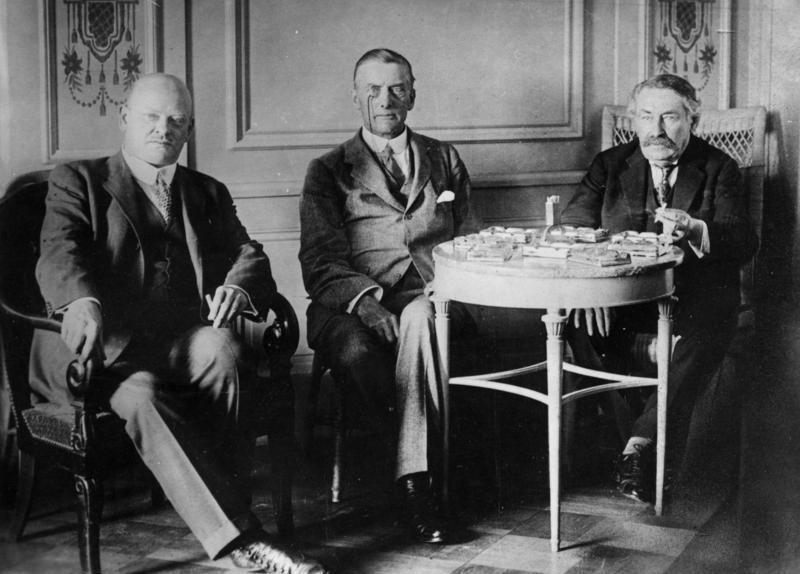
Left to right: Gustav Stresemann, Austen Chamberlain and Aristide Briand during the Locarno negotiations.
WEAKNESSES OF THE STRESA FRONT AGREEMENT
- The Stresa Front Agreement had two main flaws that ultimately led to its dissolution.
- The Stresa Front’s rules were exceedingly ambiguous. Although topics were generally discussed, there was no agreement on how France, Britain and Italy would assist the Stresa Front’s objectives in practice.
- The Stresa Front’s main goal was to prevent Hitler from violating the Treaty of Versailles. But that would necessitate a full-scale invasion of Nazi Germany. Italy, France and Britain were not ready to do this.
DISSOLUTION OF THE STRESA FRONT AGREEMENT
- The Stresa Front was unable to withstand the effects of the Abyssinian Crisis. Italy had invaded Abyssinia during the First Italo-Ethiopian War in 1895, which resulted in an embarrassing loss for the Italians. Mussolini recognised an expansionist opportunity since Italy had never let go of its desire to rule Ethiopia.
ABYSSINIAN CRISIS
- Since Britain and France had now effectively appeased Italy by giving it free rein in Ethiopia as part of their attempt to restrain Germany, Baron Vansittart got a great deal of contemporary criticism for his participation in organising the Stresa Front.
- The weak Stresa Front disintegrated with the Italian invasion of Ethiopia in October 1935.
- Italy and Ethiopia engaged in an aggressive conflict from October 1935 to February 1937, known as the Second Italo-Ethiopian Conflict or Second Italo-Abyssinian War.
- Mussolini was furious that the Anglo-German Naval Agreement was signed without his knowledge because he had long-held aspirations to rule Abyssinia.
- Mussolini informed German Ambassador Ulrich von Hassell in January 1936 that as long as Austria retained its independence, he would not object to Germany annexing it as a satellite state.
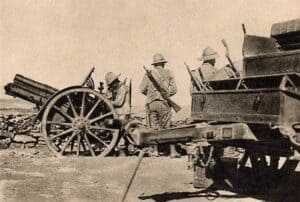
Photograph of Ethiopian soldiers holding rifles en route to the northern front. - Mussolini subsequently consented to Hitler’s remilitarisation of the Rhineland on February 1936 and declared that Italy would not uphold the Locarno Treaties if this took place.
- Italy and Germany signed the Rome-Berlin Axis, which unofficially united the two nations, in October 1936. This alliance became official when Benito Mussolini and Adolf Hitler signed the Pact of Steel on 22 May 1939.
ANGLO-GERMAN NAVAL AGREEMENT 1935
- The Anglo-German Naval Agreement was signed by Germany and Britain in June 1935. Because of this agreement, the German fleet was one-third of the size of Britain’s. The Anglo-German Naval Agreement was crucially signed without France’s or Italy’s consent.
- The pact infuriated Italy and France since it effectively allowed Germany to violate the Treaty of Versailles while assuring that Britain had a stronger fleet. Furthermore, by signing the pact, Britain virtually handed Germany permission to remilitarise.
- Following the signing of the agreement, Hitler continued to enlarge his military, boosting the strength of his army, navy and air force.
TREATY OF MUTUAL ASSISTANCE
- France was growing increasingly concerned about German remilitarisation even though they did not trust the Soviet Union, a transcontinental nation that, between 1922 and 1991, covered most of Eurasia.
- Consequently, on 2 May 1935, France and the Soviet Union signed the Treaty of Mutual Assistance. With the agreement to defend one another in the event of an attack, the treaty sought to encircle Nazi Germany.
Frequently Asked Questions
- What was the Stresa Front?
The Stresa Front was a political alliance formed in 1935 between Britain, France, and Italy to oppose Germany's rearmament and violation of the Treaty of Versailles.
- Why did Stresa Front fail?
The Stresa Front failed due to Italy's shift in alliances, as Mussolini sought closer ties with Nazi Germany. Additionally, Britain and France adopted appeasement policies towards Germany, lacking the military strength to support their demands.
- What were the terms of the Stresa Front?
Its main goals were to oppose Germany's rearmament, uphold Austria's independence, and maintain existing European borders to preserve peace.

